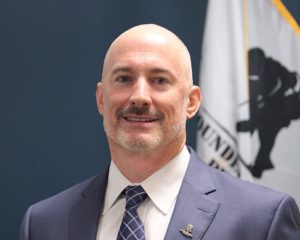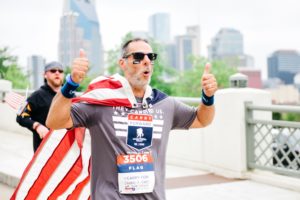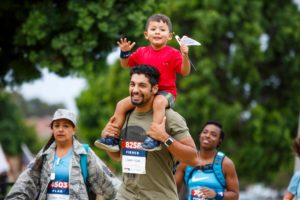 After 25 years serving medical customers and sales teammates, Gary Corless continues his service … to wounded soldiers
After 25 years serving medical customers and sales teammates, Gary Corless continues his service … to wounded soldiers
After serving customers, teammates and vendors for 25 years in med/surg distribution – including serving as CEO of PSS (now McKesson Medical-Surgical) and COO of McKesson Medical-Surgical – Gary Corless decided to step up and put his beliefs into action. In April 2015, he became chief development officer of Wounded Warrior Project®.
“Passive gratitude helps no one,” he says.
“Everything that we build professionally and personally, we build on a foundation of safety and security that we largely take for granted. That foundation doesn’t just exist. It must be fought for … and lives are lost for it and forever changed for it.
 “I had been grateful to those who served and sacrificed, but I had been mostly passively grateful. I needed to step up and put my beliefs into action.”
“I had been grateful to those who served and sacrificed, but I had been mostly passively grateful. I needed to step up and put my beliefs into action.”
Founded in 2003, Wounded Warrior Project helps serve the physical, emotional and financial needs of post-9/11 warriors and their families, so they can achieve their highest ambitions. It does so through a variety of programs, and also by supporting programs of other organizations with demonstrated abilities to fill gaps and augment its existing programs and services.
Last year, 33,067 warriors participated in the program. They join hundreds of thousands of retired and active-duty soldiers who have done so since 2003. More than 50 warriors and family members sign up every day.
Corless’ team – Warrior Support – consists of development, public awareness and marketing. This includes fueling the mission as well as promoting and protecting the organization’s mission, vision, and purpose.
 WWP programs support mental and emotional wellness, familiarization with VA benefits, education, financial planning, life skills, physical health and wellness, and career assistance.
WWP programs support mental and emotional wellness, familiarization with VA benefits, education, financial planning, life skills, physical health and wellness, and career assistance.
“It is rare that a day goes by when we don’t hear from a warrior or family member,” he says. “I can’t tell you how many times we hear, ‘It saved my marriage,’ or ‘It saved my life.’
“Sometimes the wins are clearly visible,” he continues. “They may come in the form of someone being able to stand up long enough to cook dinner or even speak after years of silence.” Or it could be a warrior landing a job, getting a degree or moving into new housing.
Post-9/11
Each generation of warriors faces similar readjustment challenges in key areas, like finding civilian employment, healing the physical wounds, and dealing with the invisible wounds of war, such as traumatic brain injury and post-traumatic stress, says Corless. They may also struggle to establish a support system back home in their communities.
But those who fought and became wounded since September 11, 2001, face some unique challenges.
Advances in medicine are saving more lives on the battlefield, which in turn means more veterans are living with severe injuries for decades, he says. And some of those injuries – such as brain injuries – may not fully exhibit themselves for years. “As a nation, we’re just learning about the impact of this type of warfare. The nature of these wounds is humbling, and it motivates us on a day-to-day basis.”
What’s more, battlefield injuries often present new challenges for the veteran as he or she ages. For example, the physical and social needs of someone who has been amputated and fitted with a prosthesis often change over time. Wounded warriors may need different medical equipment, different support systems, and even different housing as they age.
Another issue unique to today’s soldiers is the fact that they come home to a country where relatively few others share their battlefield experience, says Corless. Ninety-nine percent of the population today did not serve in today’s all-volunteer force. Active duty personnel number 1.3 million, or less than 1% of all U.S. adults.
Med/surg training ground
Twenty-five years in med/surg distribution served as a good training ground for Corless’ current work at WWP, because it helped him gain three skills:
- How to lead by serving, that is, how to help others get what they need.
- How to keep and share perspective, that is, how to stop running from task to task…deadline to deadline. Instead, taking time to see where and how we fit into the bigger picture.
- How to get over oneself, that is, how to be a grateful, hard worker.
“I cherish the 25 years I had with my team,” he says. “For us it was always about each other. We wanted more for each other than we needed from each other. I woke up every day knowing I had thousands of bosses. I still do … and I love it.” Those “bosses” are:
- “Making sure we truly understand the changing needs of the 160,000-plus injured veterans and family members we serve directly through our programs as well as the millions of post-9/11 veterans we represent through our advocacy.”
- “Making sure we have the best people, the right resources and a powerful culture.”
- “Reaching the right person with the right message at the right time, so that each American knows how he or she can make a very real and positive difference in the life of a wounded veteran.”
A look at the post-9/11 warrior
For the past 10 years, Wounded Warrior Project has conducted the largest, most statistically significant survey of this generation of wounded service members, says Gary Corless, chief development officer. “Over 30,000 warriors share their greatest challenges. Their needs guide our program investments and expectations.”
The 2018 Wounded Warrior Project Annual Warrior Survey was the ninth annual administration of the survey. The web survey was fielded to 98,054 eligible WWP warriors from March 20 to May 14, 2018, and over 33,000 warriors completed the survey. Almost half of warriors (45.3%) deployed three or more times during their military career. Almost all warriors who deployed since 2001 did so at least once to a combat area (93.4%).
Key findings
- The four most common self-reported injuries and health problems among warriors include:
- Post-traumatic stress disorder (PTSD) – 78.2%
- Sleep problems – 75.4%
- Back, neck, or shoulder problems – 73.7%
- Depression – 70.3%
- More than 60% of warriors are employed, and most (47.6%) are working full-time. The primary reasons warriors are not in the labor force include mental health injury (37.4%), physical injury (24.3%), retirement (15.6%), or current enrollment in school or in a training program (13.8%).
- Almost one quarter of warriors (22.6%) currently work for the federal government. Slightly fewer warriors (15.6%) work in the military, including those on active duty and those working in other military jobs.
- Home ownership continues to increase. Among warriors, 59.6% of warriors own homes, with or without a mortgage balance.
- About three in 10 warriors (32.4% in 2018) need the aid and attendance of another person because of their injuries and health problems. Among warriors needing assistance, approximately one-fourth (23.2%) need more than 40 hours of aid every week.
- More than eight in 10 warriors (85.8%) said maintaining their health is either very important or moderately important, and 42.1 percent of warriors do moderate-intensity physical activity or exercise three or more days a week.
- Similar to 2017, about half of warriors (49.1%) assessed their health as excellent, very good, or good, but half (50.9%) reported their health as fair or poor.
- Over 80% of warriors report that they were less productive than they would have liked because of their physical health or emotional problems. More than eight in 10 warriors (83.9%) indicated that they were less productive than they would have liked because of emotional problems.
- Female warriors are more likely than male warriors to say that their financial status is worse than a year ago (29.7% of female vs. 25.6% of male warriors). This financial trend, along with the higher homelessness rate among female warriors, is a growing area of concern to many.
- On a 10-item Social Provisions Scale, between 51.5% and 81.9% answered positively in 2018 to each statement about their current relationships with friends, family members, co-workers, community members, and others. (Example: “There are people I can depend on to help me if I really need it.”)
- Past military experiences still adversely affect many warriors. More than three-quarters of warriors (77.2%) had an experience that was so frightening, horrible, or upsetting that they were constantly on guard, watchful, or easily startled.
- Warriors understand that education is vital to improving their future opportunities. About one in four (23.2%) are now enrolled in school.
- Maintaining a healthy weight continues to be a challenge for a large majority of warriors. The average body mass index (BMI) score for warriors is 30.8, slightly above the cut-off for obesity, which is 30.0. About half (51.7%) of warriors have BMI exceeding the obesity cut-off; 6.2 percent are morbidly obese.
- Among warriors, 50.9 percent had visited a professional to get help with issues such as stress, emotional, alcohol, drug, or family problems in the prior three months, but access to care remains an issue.
Source: 2018 Wounded Warrior Project® Survey
